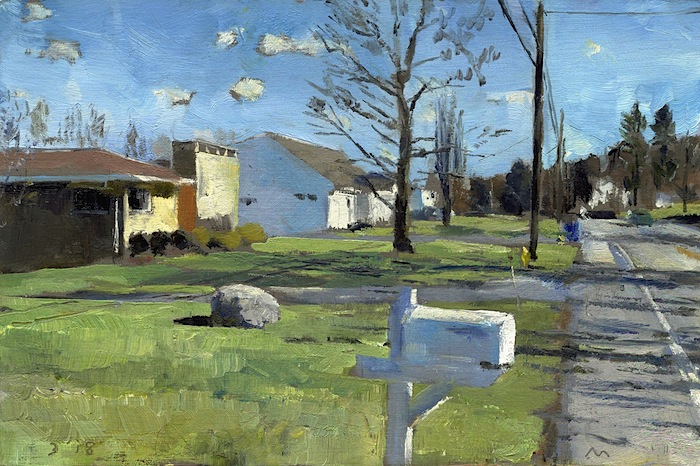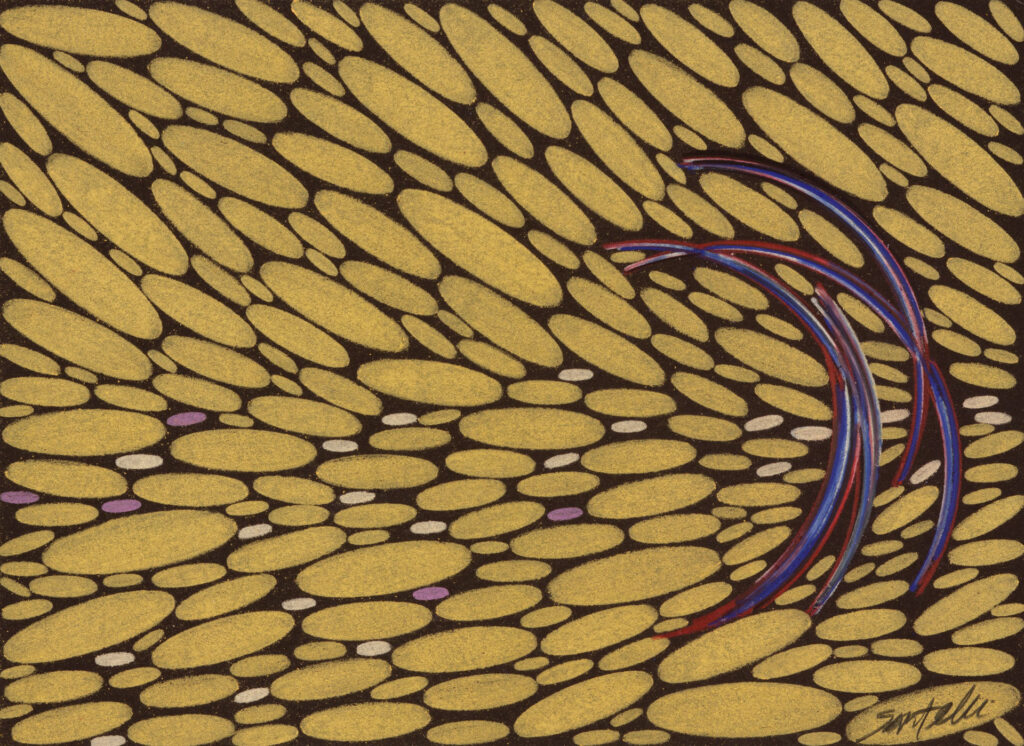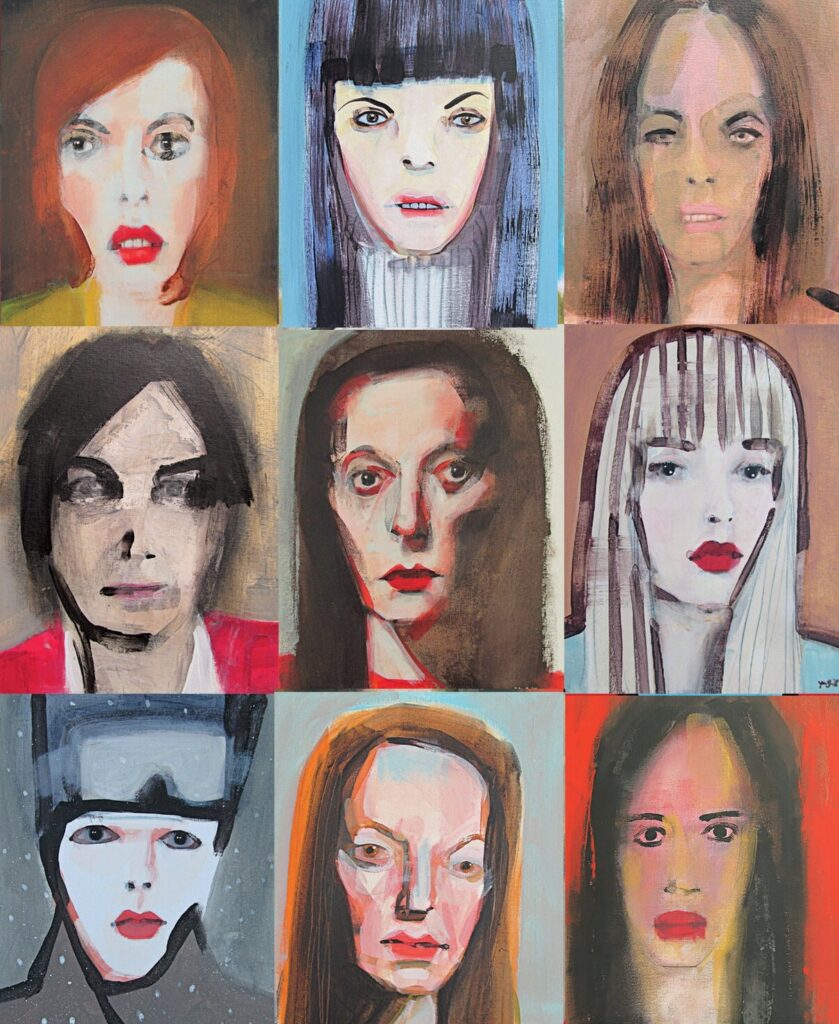January 25th, 2021 by dave dorsey

Jim Mott’s painting of a mailbox, after arriving at this spot in his Landscape Lottery.
Jim Mott came by this weekend for a conversation after a long absence, and we picked up more or less where we’d left off last time, talking partly about spirituality, art and God, BLM vs. MLK, his new art project, and some other things I ordinarily don’t talk about, like apple fritters. Though Jim is deeply political, in a way that goes back more to the Sixties than what’s happening now, he’s the least confrontational and least angry political person I know. Many people obsessed with politics seem to have embraced it as a substitute for religion. Jim already has a faith, so politics is simply a way of thinking about how to put that faith into action. What I like about his politics and his religion are the way in which they get submerged into his paint, in a sub-rosa way, neither overt nor strident, producing work that embodies his spirituality rather than illustrates it, if that makes sense. Most of the artists I’m close to are deeply spiritual, but each one in a very different way from the others. Here’s a good portion of our long conversation:
Dave: I went through this spiritual crisis in my teens and it was discovering Van Gogh who got me into it.
Jim: The crisis?
No, he got me into painting. He was so screwed up, but he responded to it by painting. He started by preaching and then went from that to painting, so it was kind of the way he dealt with there being something wrong with the world, or with him.
There’s that romantic notion or tradition that the world doesn’t get it and the individual poet does, so you’re at odds with the world.
It was just the opposite of that with me. I didn’t get it. Life was absurd and I didn’t get it, but that was repugnant to me, so at some level I knew I wasn’t right to have that perception. That was my dilemma. The idea that meaning seemed impossible and this was a crisis, a problem. It seemed the world was pointless and amounted to nothing, and this was horrifying because I couldn’t see out of that mental trap. But there’s a contradiction I didn’t see in this. Camus based The Rebel on a recognition of this contradiction: that people inwardly rebel against nihilism. If nothing matters, then there’s no reason to be dissatisfied with that, just enjoy what you can and that’s that. Why is it horrifying that life seems to amount to nothing? There’s some context in which the absurdity of life is unacceptable but if everything is genuinely pointless how can anything be unacceptable? I couldn’t get to that state of “there’s no way any of any of this can really matter, including my anguish over the impossibility of meaning, so I might as well enjoy life while it lasts.” I couldn’t reconcile myself to this nihilistic certainty I had. So I looked at Van Gogh because I assumed he had to have gone through something like that and responded to it by painting. I’d already been painting pictures of my favorite guitarists, Hendrix, Clapton, Bloomfield. I was in a band, I loved playing my Telecaster. I did the paintings just to have them on my walls. Enlarged copies of album covers. Then I read about Van Gogh and thought, hm, painting is an activity that’s interesting in itself, partly because Van Gogh, this incredibly discontented guy, was so devoted to it. Van Gogh got me to that point. My reading later gave me a way to understand this crisis I’d gone through in a spiritual perspective. So the painting and the spiritual perspective merged.
When you’re doing a good painting you feel like you’re participating in something larger than yourself, at some level it’s about ego-lessness and service. Given all that, the way the art world is all about ego competition and material symbols of success, what would happen if, I don’t know, what happens to you when you buy into that at all. You’re doing what you need to do to advance yourself but, as a result of that, cutting yourself off from your deepest, most authentic sense of what it’s all about – and that awareness of doing something in service to something larger, that awareness and how it imprints itself on the painting, that might be as important to the viewer as all the other qualities that would make a painting conventionally successful.
You mean given the art world’s definition of success. Should you fight it or resist it? That’s always a question.
You’re working to show this . . .
Mystery . .
Right. The art world wants someone who’s world-famous. If someone had handed me world fame, I’m not sure I’d turn it down, but . . .
If it does amount to something, a painting, then if you aren’t known, how do you get it out there? Something essential to your life, how do you connect it to other people?
Even with the significant but moderately narrow level of recognition we get, is it worthwhile to generate a counter-narrative about what it’s all about? As an alternative to the pursuit of the material rewards or even critical recognition. I don’t know. Just to have a small audience to tell that to, you’re still having an impact. Integration is the mission now for me: art and spirit, left and right.
<Behind him on the little end table, I always display his night painting of the Memorial Art Gallery and nearby Tom Insalaco’s painting of an eclair. We have a sidebar discussion of eclairs vs. apple fritters and where to find the best fritters, which was possibly the most impactful part of the entire conversation, but not worth transcribing.)
So what are you painting?
MORE
January 14th, 2021 by dave dorsey

Minstream 17, Bill Santelli, colored pencil on paper
A three-person exhibition, Constellations, featuring paintings, drawings, and installation works by Sara Baker Michalak, Bill Santelli, and Mizin Shin will open shortly at Main Street Arts. It’s curated around the commonality of their work. Each, in different ways, builds a patterned image—loosely or with gridded regularity—that aims for the cosmic. As with every painting, the particulars matter because of their unity within the whole work, but in this case the particulars are mostly effaced within the flow of what’s happening everywhere else.
I’ve known Bill for years and was pleased to hear that he’d been invited into this show, having seen these new drawings on Instagram over the past year. Like his Prismacolor drawings in the Path series, these explorations of thought—the honeycomb of ovals suggestive of thinking’s fragmented flow—represent a patient, repetitive and extremely disciplined practice using the simplest combinations of tone and line. In the Path series, he creates long, languid and pliant streaks of color that evoke tall grass bending in a breeze, where each line creates cells of pale monochrome. They are like leaded panes of stained glass, but also look surprisingly like glimpses of dawn breaking over wetlands.
In these newer drawings, his colors are even simpler and richer, and the minimalism of the Path drawings has been reduced to a grid of loops with less reference to nature. When I asked him to describe what went into the drawings, he wrote “I began these drawings after reading about the concept of ‘mindstream’ in Buddhist philosophy, which is described as . . . the moment-to-moment flow of sense impressions and mental phenomena.” MORE
January 6th, 2021 by dave dorsey

Does anyone still remember those skits on Conan from more than two decades ago where President Clinton would appear as a digital mask worn by Robert Smigel? The writer did a ludicrous, but hilarious, impersonation of Bubba as a Southern party boy living it up and getting away with everything and anything. “I gotsta gotsta have my snacks,” he crowed. And he was talking as much about Monica Lewinski as a side of French fries. A still shot of Clinton’s face on the monitor was lowered into the guest position beside Conan’s desk and within that motionless and grinning face, Smigel’s real-time mouth displaced Clinton’s lips—the writer’s mouth speaking his lines while the President’s face was still frozen into that vote-getting, Teflon grin. It was very funny and outrageous, and it would probably be impossible to perform these days, given much of what was being said, for many reasons. It was so over-the-top and explicit that it took on a reality all its own. (Come to think of it, that would be a good way to describe much of the art world over the last century.)
Those Smigel skits were the first thing that struck me when I saw these $100 portraits of women at The New York Times. The eyes in some of them look as if it were somehow possible to have Photoshopped them into the paintings, like Smigel’s good-old-boy accent. Could the paintings have been done on top of the photographs used as a support? Regardless, they’re good. I loved those boundary-testing skits on Conan, because they simply pointed out that when someone is doing what you want him to do, he can get away with nearly everything else in his life. Again, like the rules that once obtained in the art world. (Rewatching the first season of The Wire this week confirmed that lesson as well in terms of Baltimore politics and law enforcement as observed by David Simon.) In my view, the ends are never enough to justify the means, and integrity matters, but I may be in the minority these days.
In these one painting-per-day style portraits, Jean Smith conveys a subject’s eyes with an eerie photographic precision about how the cornea and iris reflect light, but the eyes are framed by a gesturally primitive mask. These souls are looking out at you from behind their own almost graffiti faces. A few of them I wish I’d bought: I mean, why not, for $100? But I like them. Yet her point is to undermine the economy that continues to push the ownership of visual art into an elite economic ghetto of the uber wealthy.
I shouldn’t be talking this way. The work I’m doing now takes weeks without it’s done without interruptions, usually a minimum of four weeks per painting, but also as long as two months with the sort of interruptions that you face when you actually have a life outside the studio, as I still do. No one can afford to put in four to six to eight weeks on a painting that sells for $100. But the point Nick Marino makes in his piece for the Times is that artists aren’t even reaping the actual profits of what has become an extension of the stock market—paintings are now purchased for high prices at the start and then their value is repeatedly inflated through resale or auction, simply as some corollary to day trading Silicon Valley stocks or investing in Bitcoin. (This can’t last. Our financially leveraged economic boom will not continue forever. The art world bubble will burst along with the others, but it may go on for quite a while.)
I love the idea of doing paintings quickly and selling them for unusually low prices. Jim Mott and Harry Stooshinoff are making wonderful, even remarkable paintings in this mode, along with many others. These quick portraits of women offer a continuous experimentation in ways of seeing and representing nothing more than how light lands on an individual face and how the eyes look out from the prison that personhood can seem—when in fact human individuality is the greatest miracle of life.
Excerpts from Marino’s piece:
I can appreciate that beauty has monetary value, particularly for the one and only example of a particular exquisiteness. Someone spent time making it, and that person should be compensated. But even modest artworks can be out of reach for almost anyone who’s not a real estate mogul, shipping magnate, stockbroker or oil baron. Under the sanctimonious cover of “arts patronage,” these plutocrats use art to launder their money, trading up the value of young artists and enriching one another in the process. The artists, meanwhile, get paid only once, on the initial sale. The end result is (artwork) that costs as much as a Honda Civic.
Opting not to use a gallery, Smith listed each of her works on Facebook for the ludicrously low price of $100. She could certainly charge more, but the egalitarian price is the point. It’s her version of the $5 tickets Fugazi used to sell to its all-ages shows — and anyway, she has never needed much to survive. For the past quarter-century, she has lived alone and monastically in an apartment without a sofa or kitchen table (she eats off a filing cabinet), and her monthly expenses, including rent and utilities, total about $1,000. She only needs to sell 10 pieces per month to break even — though that has never been her problem.
Well, that’s all she needs to make if she doesn’t pay taxes. But at that level of income, she wouldn’t need to pay taxes. He points out that having created an insatiable demand for her low-budget art, she can’t keep up with it. The question is, does she keep her prices low or do what the free market naturally does when demand far exceeds supply: let prices rise as far as demand will lift them. I’m guessing it will depend on whether she ever gets a mortgage. I hope she continues to live monastically, as Marino describes her lifestyle. Monastic is almost always unimpeachable as a way to live, especially for an artist. Thoreau, or “Pond Scum” as The New Yorker referred to him once (at the link, you’ll see a note at the bottom of the essay pointing out the original headline), proved that monastic individuality isn’t such a bad way to live until people come in the winter and start cutting up your pond and selling it as blocks of ice.
The other takeaway here: hey, Facebook is still good for something.


